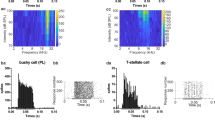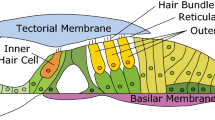Abstract
Several distinct mechanisms have evolved in the auditory periphery to extract frequency information from a sound. In the mammalian cochlea, a travelling wave on the basilar membrane1 enhanced by a physiologically vulnerable neuro-mechanical interaction2,3 performs the primary frequency separation. In lizards, tuning is likely to depend on structures in the papilla other than the basilar membrane4, and tuning in the auditory nerve is correlated with the length of the stereocilia5. In turtles6 and possibly some bird species7, an electrical resonance in the receptor cells is responsible for frequency selectivity. In addition to those organs obviously specialized to detect acoustic stimuli, afferents of the vestibular system can exhibit tuning to low-frequency airborne sounds8,9, despite the absence of mechanical frequency separation by accessory structures. I report here that in the frog saccule, a vestibular organ apparently constructed for the detection of vibratory accelerations8–10, frequency tuning may arise from an electrical resonance intrinsic to the hair cells. The mechanism is similar to that found in turtle6 and ensures that a stimulus with frequency corresponding to the membrane resonant frequency will produce the largest signal in the cell. This type of tuning may thus be quite widespread. Oscillatory mechanisms have been reported in sensory cells of other modalities in several lower vertebrates6,11,12, and may even contribute to their sensitivity, although such mechanisms do imply that the signal-to-noise ratio is degraded near threshold.
This is a preview of subscription content, access via your institution
Access options
Subscribe to this journal
Receive 51 print issues and online access
$199.00 per year
only $3.90 per issue
Buy this article
- Purchase on Springer Link
- Instant access to full article PDF
Prices may be subject to local taxes which are calculated during checkout
Similar content being viewed by others
References
v. Bekesy, G. Experiments in Hearing (McGraw-Hill, New York, 1960).
Davis, H. Hearing Res. 9, 79–90 (1983).
Sellick, P. M., Patuzzi, R. & Johnstone, B. M. J. acoust. Soc. Am. 72, 131–141 (1982).
Weiss, T. F., Peake, W. T., Ling, A. & Holton, H. in Evoked Electrical Activity in the Auditory Nervous System (eds Naunton, R. F. & Fernandez, C.) 91–112 (Academic, London, 1978).
Turner, R. G., Muraski, A. A. & Nielson, D. W. Science 213, 1519–1521 (1981).
Crawford, A. C. & Fettiplace, R. J. Physiol., Lond. 312, 377–412 (1981).
Manley, G. A. Naturwissenschaften 66, 582–84 (1979).
Lewis, E. R., Leverenz, E. C. & Koyama, H. J. comp. Physiol. 145, 437–445 (1982).
Koyama, H., Lewis, E. R., Leverenz, E. L. & Baird, R. A. Brain Res. 250, 168–172 (1982).
Moffat, J. M. & Capranica, R. J. comp. Physiol. 105, 1–8 (1976).
Clusin, W. T. & Bennett, M. V. L. J. gen. Physiol. 69, 145–182 (1977).
Fain, G. L., Gerschenfeld, H. M. & Quandt, F. J. Physiol., Lond. 303, 495–513 (1980).
Ashmore, J. F. & Russell, I. J. J. Physiol., Lond. 329, 26P–27P (1982).
Hudspeth, A. J. & Corey, D. P. Proc. natn. Acad. Sci. U.S.A. 74, 2407–2411 (1977).
Corey, D. P. & Hudspeth, A. J. Nature 281, 675–677 (1979).
Weiss, T. F. Hearing Res. 7, 353–360 (1982).
Harris, G. G. J. acoust. Soc. Am. 44, 176–186 (1968).
Sommerfeld, A. Thermodynamics and Statistical Mechanics (Academic, New York, 1956).
Ashmore, J. F. & Russell, I. J. J. submicrosc. Cytol. 15, 163–166 (1983).
Art, J. J., Crawford, A. C., Fettiplace, R. & Fuchs, P. Proc. R. Soc. B216, 377–384 (1982).
Eatock, R. A., Corey, D. P. & Hudspeth, A. J. Soc. Neurosci. Abstr. 5, 19 (1979).
Author information
Authors and Affiliations
Rights and permissions
About this article
Cite this article
Ashmore, J. Frequency tuning in a frog vestibular organ. Nature 304, 536–538 (1983). https://doi.org/10.1038/304536a0
Received:
Accepted:
Issue Date:
DOI: https://doi.org/10.1038/304536a0
This article is cited by
-
Hair cell force generation does not amplify or tune vibrations within the chicken basilar papilla
Nature Communications (2016)
-
Hair Cells – Beyond the Transducer
Journal of Membrane Biology (2006)
-
Models of membrane resonance in pigeon semicircular canal type II hair cells
Biological Cybernetics (1991)
-
Voltage oscillations and ionic conductances in hair cells isolated from the alligator cochlea
Journal of Comparative Physiology A (1988)
Comments
By submitting a comment you agree to abide by our Terms and Community Guidelines. If you find something abusive or that does not comply with our terms or guidelines please flag it as inappropriate.



